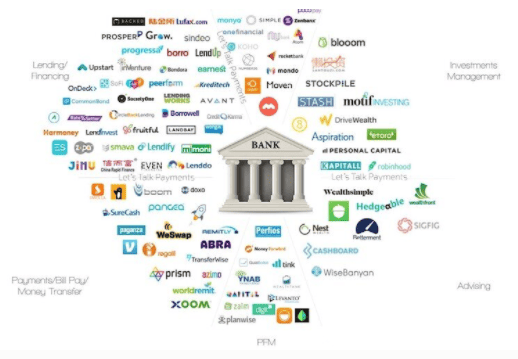Updated 10/12/2023
One of the more disputed parts of the Dodd-Frank Act passed in 2010 following the Great Financial Crisis, is the Durbin Amendment, which limits the interchange fees banks can charge for debit cards.
Those fees were in the billions, and they created two levels of routing for debit cards, signature and pin-less, which creates two different charges for retailers.
Retailers started the move towards capping the fees in the 1980s when plastic debit card use started to increase, and make no mistake; retailers hate these fees because they eat into their profits. Banks loved the fees because they were easy money for them, but after creating the Durbin Amendment, they turned to other fees to replace those lost revenues.
The capping of the interchange fees was no panacea for all sides; the fees for retailers decreased, and the banks increased fees for their customers. But along came fintechs, which fall outside the Durbin Amendment, and with their ease of use embraced by customers, here came higher interchange fees for the retailers.
In today’s post, we will learn:
- What is the Durbin Amendment?
- What is an Interchange Cap Fee?
- How Does This Impact Banks, Fintechs, and Retailers
Let’s dive in and learn more about the Durbin Amendment interchange cap.
What is the Durbin Amendment?
The Durbin Amendment, according to Investopedia:
“The Durbin Amendment is a part of the Dodd-Frank Wall Street Reform and Consumer Protection Act that limits transaction fees imposed upon merchants by debit card issuers. The amendment, named after U.S. Senator Richard J. Durbin and introduced in 2010, proposed restricting these interchange fees, which averaged 44 cents per transaction at the time of proposal. The Durbin Amendment reduced transaction fees to 21 cents plus 0.05% of the transaction value for banks with $10 billion or more in assets.”
To put the numbers in perspective, let’s take a $5 purchase, which gives the interchange fee at $5 x 0.05% + $0.21 = $0.21.

That ruling applies to big banks like Wells Fargo, Citibank, JP Morgan, and US Bank but also to regional banks like Fifth Third, Truist, and PNC. The amendment doesn’t apply to banks smaller than $10 billion in assets and fintechs, like PayPal or Square.
Those under the asset cap or fintechs that fall outside the Amendment have a ceiling of 0.80%-1.05% + a $0.15-$0.20 transaction fee.
Returning to our previous example of $5, here is how much these financials can charge. The interchange fee at the highest rate is $5 x 1.05% + $0.20 = $0.25.
You are probably thinking four cents. Big deal, Dave. Well, if you think about the billions of transactions that occur within a year, Visa processed over $806 billion in debit card transactions for the first quarter of 2021 alone.
Consider this: the average American makes 68 payments a year, with 23 of those coming from debit cards. So, if we look at the difference between the two transactions, depending on who owns that debit card:
- Wells Fargo = 23 x $0.21 = $4.83
- PayPal = 23 x $0.25 = $5.75
And then, if we project that over the millions of Americans who use debit cards, those are big boy numbers. In fact, estimates after adopting the Durbin Amendment predicted that banks would lose around $14 billion yearly in fees.
Not to mention the impact on retailers, that four cents also comes out of the retailer’s bottom line, and not all retailers can pass along those increases. Yes, Starbucks adds the extra to their lattes, but the taco truck may not pass along those increases.
In other words, before the passing of the Durbin Amendment, smaller transactions charged smaller fees, and larger transactions charged bigger fees. However, once passed, Visa and Mastercard began charging the maximum for any transaction, regardless of size.
Before the Durbin Amendment, interchange fees were negotiable, which worked well for small mom-and-pop retailers, but after passing, the government put a minimum floor on every transaction and a ceiling. All of which drove up fees for smaller retailers and harmed the sector they intended to help.
The biggest debate about the usefulness and impact of the Durbin Amendment on retailers, consumers, and banks remains that larger retailers and fintechs have raised rates in other ways instead of passing along savings to consumers.
In other words, they are working around the Durbin Amendment and taking advantage of the loophole of the market cap, and for retailers that have pricing power, increasing their prices to increase their margins.
In response to the Amendment, banks started including high fees on deposit accounts, increased overdraft fee penalties, and created monthly maintenance charges for accounts that didn’t meet pre-determined criteria such as low account balances or lack of use of debit cards.
Now, while the focus of the Durbin Amendment was on debit card transactions, comparable fees on credit card usage were not affected. That has led some banks to increase rewards for credit card usage to encourage more use and drive more revenues, offsetting the increased reward costs.
There is some discussion in Congress regarding extending the Durbin Amendment to cover credit cards, but it has not come to fruition as of the writing of this article.
What is An Interchange Cap Fee?
The interchange cap fee is:
“An interchange fee is a fee that card issuers charge merchants for processing customer transactions paid with a credit or debit card. The interchange fees are meant to cover the costs associated with processing card transactions.”
The interchange fee is the fee that every merchant must pay for allowing customers to use debit cards or credit cards as a means of payment. These fees are also known as “swipe fees.” And financial companies such as Visa, Wells Fargo, and PayPal can charge this fee in return for enabling electronic payments.

The fee covers the credit risk and handling debit and credit card transaction charges.
The leading credit card companies such as Visa, Mastercard, American Express, and Discover set the interchange fees, which they review periodically, usually semiannually, typically in April and October.
They calculate the fee based on several costs:
- Authorization costs
- Losses due to fraud
- Losses due to credit
- Average bank cost of funds
The interchange fee rate is also called the issuer’s reimbursement fee. The flow follows that the merchant acquirer pays the interchange fee to the issuing bank, passing that charge onto the cardholder.
For example, Fiserv, which enables the merchant to process the fee, pays the fee to Wells Fargo, who issues the debit card to us, who then pays the interchange fee.
Each credit card or debit card company sets its interchange fee rates, but the merchant bank (Fiserv) or institution (PayPal) pays the fee, conducting a transaction with a cardholder.
In addition to the interchange fee, card processing companies (Stripe) may include additional fees that they pass along to retailers.
To add complexity to these transactions, different types of cards that card issuers are coming from Paypal, for example, are assigned different interchange rates. There are also various fees depending on how the consumer completes the transaction.
For example, suppose a consumer swipes their Visa-branded debit card at a store. In that case, it will have a different interchange rate compared to the transaction transacted on the same retailer’s website or if it is done manually. The Visa prepaid debit card also carries a different interchange rate than a business debit card. And finally, the size of the retailer or business affects the rates they charge because they can negotiate different rates than the mom-and-pop retailer because of the volume they process.
The Durbin Amendment puts a cap or limit on the interchange fees that Visa, Mastercard, and others can charge for debit card transactions.
But, the above fees and interchange fees charged to retailers are exempt from the Durbin Amendment if they fall under those asset cap limits.
Visa, which has tremendous power when setting interchange rates, publishes its current rates effective April 15, 2021. here are a few of their published rates; the rates shown are exempt from the Durbin Amendment. To see the complete list, click here.
Card Present | Exempt rates |
Supermarket, debit | $0.30 |
Retail, debit | 0.80% + $0.15 |
Small ticket, debit | 1.55% + $0.04 |
Retail Key Entry, debit | 1.65% + $0.15 |
Card Not Present | |
Retail 2 – Card not present | 0.65% + $0.15 ($2.00 cap) |
Card not present, debit | 1.65% + $0.15 |
The above rates are exempt from the Durbin Amendment if processed on a card issued by a bank with less than $10 billion in assets or someone like PayPal. How that is possible we will explore in the next section.
How Does This All Affect Banks and Fintechs?
When Congress passed the Durbin Amendment and all the exceptions laid out, the fintech industry, including neo-banks, was nowhere on the horizon and nothing anyone considered.
But fast forward to today, post-Covid, we see the rise of fintechs, and consumers continue to embrace the use of fintechs to pay for everything. Also, add in the rise of online consumers and the need for online payments, which fintechs easily enable.
That asymmetry the Durbin Amendment creates is critical to the success of fintechs and neo-banks. Many of these companies, such as Square with the Cash Card, offer debit cards as a financial product, along with others that offer “charge” cards, such as Fleetcor, with their gas cards.
Companies like Square are not banks themselves; they typically partner with an existing bank to offer products like the Cash Card.
And to slide under the Durbin Amendment, they don’t just partner with any banks; instead, these companies partner with banks that have less than $10 billion in assets. That allows them to issue debit cards to their customers, allowing them to charge higher interchange fees while making them exempt from the Durbin Amendment.
Below is a list of some of the popular banks that fintechs partner with:
- Bancorp Bank with < $7 billion in assets
- Green Dot Bank < than $3 billion in assets
- Sutton Bank with < $1 billion in assets
- Emigrant Ban with < $4 billion in assets
Here is a checklist of some of the fintechs and their partner banks:
Company/Product | Partner Bank |
Apple Card | Green Dot Bank |
Walmart Money Card | Green Dot Bank |
Chime | Bancorp Bank |
PayPal (Venmo Debit Card) | Bancorp Bank |
Marqueta | Sutton Bank |
Robinhood | Sutton Bank |
Square | Sutton Bank |
Affirm | Cross River |
Stripe | Cross River |
This means that companies like Stripe, Square, PayPal, and Chime, for example, can earn higher interchange fees than if they needed to adhere to the Durbin Amendment, like Visa and JP Morgan.
Data from the Fed shows that the average interchange fee on the Durbin-exempt fintech-issued cards is 44 cents per transaction, almost double the ceiling that banks like JP Morgan can charge.
The higher fees that fintechs can make from their customers have impacts on their businesses, compared to the big banks:
- The fintechs can and do spend more on acquiring customers because those customers are more valuable to the fintechs than the big banks.
- Fintechs also can operate in niches that are profitable to them, where they are not for big banks.
- Fintechs can pass along the higher costs through rewards and other incentives, making their debit cards more attractive to customers. For example, Square’s Cash Card offers discounts on purchases you can easily enable from your iPhone app and apply immediately.
- The increased revenue allows fintechs to spend more on R&D and customer service on a per-customer basis relative to the big banks. The increased spending allows the fintechs to improve their tech to serve the customer better.
Many of the above benefits or advantages stem from the upsides fintechs enjoy because of partnering with banks under the Durbin Amendment market cap.
These advantages also lend themselves to fintechs providing additional enticements to their platforms, such as no investment fees, receiving your direct deposit early, and contactless debit card payments.
The fintechs enjoy many of these advantages because of the Durbin Amendment, but most, if not all, are tech-focused, which lends itself to creating more leading-edge products and being more flexible. The tech focus also allows them to meet the consumer where they want, making payments easier and more seamless and reducing friction.
The perfect example of ease of use and reducing friction is a recent story of a customer opening a Square account while pumping gas and using the Square payment to pay for the gas. That kind of optionality is not available from the big banks, period.
The Durbin Amendment gives the fintechs better economics with each customer, which gives them more flexibility to offer better rewards and reduce friction relative to the big banks.
Investor Takeaway
To understand the rise and growth in the fintech sector, we need to understand their economics and the advantages they enjoy compared to the big banks.
The Durbin Amendment gives the fintech a loophole to exploit to gain a competitive advantage over JP Morgan. At this point, JP Morgan and the other big banks are not doing much to counteract that advantage, although they are aware of the issue.
For example, Jamie Dimon recently stated in his recent shareholder letter:
“And because of the Durbin Amendment, if a bank has a customer with a small checking account who spends $20,000 a year on a debit card, the bank will only receive $120 in debit revenue – while a small bank or nonbank would receive $240. This difference may determine whether you can even compete in certain customer segments. It’s important to note that while some of the fintechs have done an excellent job, they may actually be more expensive to the customer.”
For some of the smaller startup fintechs, enjoying the benefits of the higher interchange rates makes sense, but for others like PayPal and Apple, with market caps of $285 billion and $2.47 trillion, respectively, now dwarf the market cap of the bigger banks, minus JP Morgan.
My guess was when the regulators envisioned the Durbin Amendment, companies like PayPal and Apple were not what they had in mind.
Understanding the economics that fintechs enjoy is part of analyzing these companies, and how they use those advantages to grow will be instrumental to their continued success. It is also important to keep track of the Durbin Amendment and its changes because any changes will profoundly impact big banks and fintechs.
And with that, we will wrap up our discussion on the Durbin Amendment and interchange caps.
Thank you, as always, for taking the time to read this post, and I hope you find some value. If I can further assist, please don’t hesitate to reach out.
Until next time, take care and be safe out there,
Dave

Dave Ahern
Dave, a self-taught investor, empowers investors to start investing by demystifying the stock market.
Related posts:
- The Future of Debit Card Processing, What It Is and How It Works Updated 10/27/2023 In 2020, the Federal Reserve Bank of Atlanta conducted a Survey of Consumer Choice, which reported that: Evidence also shows that increasing debit...
- Pin Debit Networks: A Guide to This Unknown World Updated 9/25/2023 In a survey recently released by the Federal Reserve Bank of Atlanta, U.S. consumers use their debit cards to make payments 68% of...
- Key Players in the Payment Processing Flow Updated 11/9/2023 Analysts expect global payment revenues to grow to $2.5 trillion by 2025, according to McKinsey, after returning to their historical 6 to 7...
- How Payment Processing Works: A Guide for Beginners Updated 4/4/2024 How many of you still carry cash, or how many of us still pay for anything with cash? If you are like me,...

